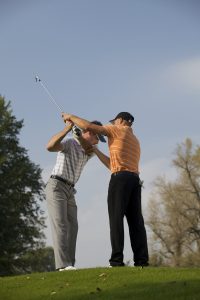
Golf professional helping young man with his swing
You might see someone undergoing a swing change who hits almost every ball poorly, but they stick with it under the guise of getting worse before getting better. However in fact, this person may not actually be on the right path. The question becomes, how can we distinguish between someone getting worse who will eventually get better, as opposed to someone getting worse before…staying that way?
We can start with these two tenets: 1) Students who execute our instruction properly during a given swing should hit the ball better with that swing. 2) Students who execute our instruction properly, but either don’t see improvement or hit the ball worse, means that our instruction is incorrect.
Now, the student who sees ball striking improvement with our instruction may get worse in terms of consistency. That’s the key word. In most cases they’re still going to hit more poor shots than good ones initially, but as long as they’re hitting some good shots and seeing a better ball flight on occasion, then we’re on the right track. Here’s an example:
Bob is chicken-winging his left elbow through impact, which we diagnose to be his major problem. We get Bob to turn his body better through impact, eliminating the chicken wing. He hits some good shots, but also some bad ones. Do the bad shots mean he’s not executing our instruction correctly? In a very narrow sense, yes, but that’s too strict of a measure. The key here is that Bob is seeing an improvement in his ballstriking on some shots, but he has yet to learn the nuances involved in the new move, making it understandable why he hits many poor shots initially. We’re on the right path. Bob’s scores may suffer for a while, but eventually he’ll turn it around and start improving. Here’s where “getting worse before getting better” makes sense.
We’ll use the same example for the second tenet mentioned earlier. We get Bob to turn his body better through impact, eliminating the chicken wing, but he can’t hit a good shot to save his life. Should we just tell Bob he needs to just grin and bear it, that you have to get worse before you get better? No. And what’s worse, that’s lazy teaching. We may have correctly diagnosed Bob’s problem and come up with the correct solution, but people aren’t like robots that we can program to be automatic.
So now we have to find a way for Bob to start seeing some good results at least once in a while. For example, maybe he had to stand too close to the ball with his old swing because of the reduced radius; now he’s got a bigger radius and is not used to it. Standing farther away may help his cause. Whatever the reason Bob is struggling, we have to come up with a way for him to hit the ball better– at least occasionally – before the lesson ends. More often than not, this involves giving him an additional key to focus on, or making a secondary change to go with the main one.
One aspect that needs to be discussed is when we accurately diagnose the problem, give the proper cure, and the student just cannot get it, no matter what. It’s tempting to send the student on his way, telling him to just keep working on it and to remember that you have to get worse before you get better. But such action is akin to teaching malpractice. It may be hard to abandon what we know to be the correct solution, but if it becomes obvious the student will never get it, we must change course.
Copyright © 2023 United States Golf Teachers Federation, All Rights Reserved
200 S. Indian River Drive, Suite #206, Fort Pierce, FL 34950
772-88-USGTF or 772-595-6490 - www.usgtf.com
200 S. Indian River Drive, Suite #206, Fort Pierce, FL 34950
772-88-USGTF or 772-595-6490 - www.usgtf.com
